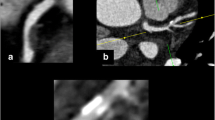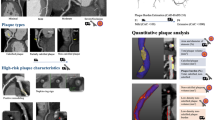Abstract
Although the quantification of coronary arterial calcification (CAC) correlates well with disease burden, calcified plaques only represent a portion of the total plaque burden. Contrast-enhanced multidetector CT angiography has emerged as a promising noninvasive tool to directly examine the coronary artery wall and accurately determine atherosclerotic plaque burden and composition. Published literature on plaque subtypes (noncalcified, mixed, and calcified) suggests that mixed plaque burden is more likely to be associated with high-risk groups, such as those with diabetes mellitus, inflammatory biomarkers, increasing stenotic coronary artery disease, myocardial perfusion defects, higher CAC scores and, more importantly, features of plaque instability such as thin-cap fibroatheroma. One small study suggested that mixed plaque burden can predict cardiovascular outcomes. Based on emerging data, determination of mixed plaque burden appears more promising, but the value of exclusively calcified and noncalcified plaque is less convincing.
Similar content being viewed by others
References and Recommended Reading
Smith SC Jr, Jackson R, Pearson TA, et al.: Principles for national and regional guidelines on cardiovascular disease prevention: a scientific statement from the World Heart and Stroke Forum. Circulation 2004, 109:3112–3121.
Budoff MJ, Achenbach S, Blumenthal RS, et al.: Assessment of coronary artery disease by cardiac computed tomography: a scientific statement from the American Heart Association Committee on Cardiovascular Imaging and Intervention, Council on Cardiovascular Radiology and Intervention, and Committee on Cardiac Imaging, Council on Clinical Cardiology. Circulation 2006, 114:1761–1791.
Nasir K, Shaw LJ, Liu ST, et al.: Ethnic differences in the prognostic value of coronary artery calcification for allcause mortality. J Am Coll Cardiol 2007, 50:953–960.
Budoff MJ, Shaw LJ, Liu ST, et al.: Long-term prognosis associated with coronary calcification: observations from a registry of 25,253 patients. J Am Coll Cardiol 2007, 49:1860–1870.
Detrano R, Guerci AD, Carr JJ, et al.: Coronary calcium as a predictor of coronary events in four racial or ethnic groups. N Engl J Med 2008, 358:1336–1345.
Rumberger JA, Simons DB, Fitzpatrick LA, et al.: Coronary artery calcium area by electron-beam computed tomography and coronary atherosclerotic plaque area. A histopathologic correlative study. Circulation 1995, 92:2157–2162.
Budoff MJ, Dowe D, Jollis JG, et al.: Diagnostic performance of 64-multidetector row coronary computed tomographic angiography for evaluation of coronary artery stenosis in individuals without known coronary artery disease: results from the prospective multicenter ACCURACY (Assessment by Coronary Computed Tomographic Angiography of Individuals Undergoing Invasive Coronary Angiography) trial. J Am Coll Cardiol 2008, 52:1724–1732.
Cury RC, Pomerantsev EV, Ferencik M, et al.: Comparison of the degree of coronary stenoses by multi-detector computed tomography versus by quantitative coronary angiography. Am J Cardiol 2006, 96:784–787.
Leber AW, Knez A, Becker A, et al.: Accuracy of multidetector spiral computed tomography in identifying and differentiating the composition of coronary atherosclerotic plaque: a comparative study with intracronary ultrasound. J Am Coll Cardiol 2004, 43:1241–1247.
Achenbach S, Moselewski F, Ropers D, et al.: Detection of calcified and noncalcified coronary atherosclerotic plaque by contrast-enhanced, submillimeter multidetector spiral computed tomography: a segment-based comparison with intravascular ultrasound. Circulation 2004, 109:14–17.
Naghavi M, Libby P, Falk E, et al.: From vulnerable plaque to vulnerable patient: a call for new definitions and risk assessment strategies: part II. Circulation 2003, 108:1772–1778.
Leber AW, Knez A, von Ziegler F, et al.: Quantification of obstructive and nonobstructive coronary lesions by 64-slice computed tomography: a comparative study with quantitative coronary angiography and intravascular ultrasound. J Am Coll Cardiol 2005, 46:147–154.
Leber AW, Becker A, Knez A, et al.: Accuracy of 64-slice computed tomography to classify and quantify plaque volumes in the proximal coronary system: a comparative study using intravascular ultrasound. J Am Coll Cardiol 2006, 47:672–677.
Sun J, Zhang Z, Lu B, et al.: Identification and quantification of coronary atherosclerotic plaques: a comparison of 64-MDCT and intravascular ultrasound. AJR Am J Roentgenol 2008, 190:748–754.
Schmid M, Pflederer T, Jang IK, et al.: Relationship between degree of remodeling and CT attenuation of plaque in coronary atherosclerotic lesions: an in-vivo analysis by multi-detector computed tomography. Atherosclerosis 2008, 197:457–464.
Galonska M, Ducke F, Kertesz-Zborilova T, et al.: Characterization of atherosclerotic plaques in human coronary arteries with 16-slice multidetector row computed tomography by analysis of attenuation profiles. Acad Radiol 2008, 15:222–230.
Bamberg F, Dannemann N, Shapiro MD, et al.: Association between cardiovascular risk profiles and the presence and extent of different types of coronary atherosclerotic plaque as detected by multidetector computed tomography. Arterioscler Thromb Vasc Biol 2008, 28:568–574.
Funabashi N, Asano M, Komuro I: Predictors of non-calcified plaques in the coronary arteries of 242 subjects using multislice computed tomography and logistic regression models. Int J Cardiol 2007, 117:191–197.
Rivera JJ, Nasir K, Choi EK, et al.: Traditional risk factors and coronary plaque composition assessed by noninvasive CT angiography in asymptomatic individuals. Circulation 2008, 118:S776.
Ibebuogu UN, Nasir K, Gopal A, et al.: Comparison of coronary atherosclerotic plaque burden and composition between diabetic and nondiabetic patients by noninvasive CT angiography. Arterioscler Thromb Vasc Biol 2008, 28:E134–E135.
Rivera JJ, Nasir K, Choi EK, et al.: Detection of occult coronary artery disease in asymptomatic individuals with diabetes mellitus using non-invasive cardiac angiography. Atherosclerosis 2008 Aug 5 (Epub ahead of print).
Rivera JJ, Nasir K, Choi EK, et al.: Increasing levels of hemoglobin A1c are associated with the presence of mixed coronary plaques in asymptomatic individuals without diabetes mellitus. Circulation 2008, 118:S775–S776.
Nasir K, Gopal A, Ahmadi N, et al.: Gender differences in atherosclerotic plaque composition by noninvasive CT angiography. Circulation 2008, 117:E426.
Broedl UC, Lebherz C, Lehrke M, et al.: Low adiponectin levels are an independent predictor of mixed and non-calcified coronary atherosclerotic plaques. J Am Coll Cardiol (in press).
Rivera JJ, Nasir K, Choi EK, et al.: Elevated high-sensitive C reactive protein and white blood cell count are strongly associated with mixed plaque burden assessed by noninvasive cardiac computed tomography angiography in asymptomatic subjects. Accepted for presentation at the 58th Annual Scientific Session of the American College of Cardiology.
Hamirani YS, Nasir K, Gopal A, et al.: Atherosclerotic plaque composition among patients with stenotic coronary artery disease on noninvasive CT angiography [abstract]. J Cardiovasc Comput Tomogr 2008, 2:S44–S45.
Feuchtner G, Jodocy D, Cury RC, et al.: Atherosclerotic plaque composition among patients with stenotic coronary artery disease on noninvasive coronary CT angiography. Circulation 2008, 118:S598.
Lin F, Shaw LJ, Berman DS, et al.: Multidetector computed tomography coronary artery plaque predictors of stressinduced myocardial ischemia by SPECT. Atherosclerosis 2008, 197:700–709.
Beckman JA, Ganz J, Creager MA, et al.: Relationship of clinical presentation and calcification of culprit coronary artery stenoses. Arterioscler Thromb Vasc Biol 2001, 21:1618–1622.
Nasir K, Rivera JJ, Choi EK, et al.: A higher coronary artery calcium score is associated with a greater mixed and heterogeneous plaque burden on coronary computed tomography angiography. J Am Coll Cardiol 2008, 51:A155.
Virmani R, Kolodgie FD, Burke AP, et al.: Lessons from sudden coronary death: a comprehensive morphological classification scheme for atherosclerotic lesions. Arterioscler Thromb Vasc Biol 2000, 20:1262–1275.
Pundziute G, Schuijf JD, Jukema JW, et al.: Evaluation of plaque characteristics in acute coronary syndromes: noninvasive assessment with multi-slice computed tomography and invasive evaluation with intravascular ultrasound radiofrequency data analysis. Eur Heart J 2008, 29:2373–2381.
Ehara S, Kobayashi Y, Yoshiyama M, et al.: Spotty calcification typifies the culprit plaque in patients with acute myocardial infarction: an intravascular ultrasound study. Circulation 2004, 110:3424–3429.
Sarwar A, Shaw LJ, Shapiro MD, et al.: Diagnostic and prognostic value of absence of coronary artery calcification: the significance of zero. J Am Coll Cardiol Imaging (in press).
Pundziute G, Schuijf JD, Jukema JW, et al.: Prognostic value of multislice computed tomography coronary angiography in patients with known or suspected coronary artery disease. J Am Coll Cardiol 2007, 49:62–70.
Nasir K, Budoff MJ, Shaw LJ, Blumenthal RS: Value of multislice computed tomography coronary angiography in suspected coronary artery disease. J Am Coll Cardiol 2007, 49:2070–2071.
Author information
Authors and Affiliations
Corresponding author
Rights and permissions
About this article
Cite this article
Nasir, K., Rivera, J.J., Chang, HJ. et al. Calcified versus noncalcified atherosclerosis: Implications for evaluating cardiovascular risk. Curr Cardio Risk Rep 3, 150–155 (2009). https://doi.org/10.1007/s12170-009-0024-9
Published:
Issue Date:
DOI: https://doi.org/10.1007/s12170-009-0024-9




